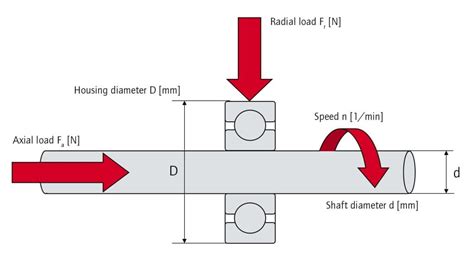Axial Bearings: The Unsung Heroes of Modern Machinery
In the realm of mechanical engineering, axial bearings play a pivotal role, supporting countless applications in industries ranging from aerospace and automotive to heavy machinery and precision instruments. Their ability to withstand axial loads while enabling smooth rotation makes them indispensable for a wide array of mechanical systems.
Understanding Axial Bearings
Axial bearings are specialized types of bearings designed to support axial loads, which are forces acting parallel to the axis of rotation. Unlike radial bearings, which support loads perpendicular to the axis, axial bearings prevent axial displacement while allowing free rotation.
Types of Axial Bearings
There are several different types of axial bearings, each with its own unique design and applications:

-
Thrust ball bearings: Utilize ball elements between grooved raceways to accommodate axial loads, offering high load capacity and low friction.
-
Thrust roller bearings: Similar to thrust ball bearings, but use cylindrical rollers instead of balls for increased load capacity and durability.
-
Tapered roller thrust bearings: Feature tapered rollers arranged in a cone shape, providing high axial load capacity and resistance to misalignment.
-
Hydrostatic bearings: Utilize a pressurized fluid film to support axial loads, eliminating friction and wear.
-
Magnetic bearings: Employ electromagnetic forces to levitate shafts, providing frictionless support and high precision.
Applications of Axial Bearings
Axial bearings find applications in a diverse range of industries, including:
- Aerospace: Supporting aircraft engines, propellers, and landing gear.
- Automotive: Used in transmissions, differentials, and steering systems.
- Heavy machinery: Supporting shafts in mining equipment, construction machinery, and wind turbines.
- Precision instruments: Ensuring accurate rotation in medical devices, measuring instruments, and robotics.
Benefits of Axial Bearings
The use of axial bearings offers several advantages:
-
High load capacity: Designed to withstand significant axial loads, enabling their use in demanding applications.
-
Low friction: Minimize friction between rotating surfaces, reducing energy consumption and wear.
-
Compact design: Can be integrated into space-constrained applications due to their compact size.
-
Speed capability: Capable of supporting high speeds, making them suitable for applications involving rapid rotation.
-
Long service life: With proper maintenance, axial bearings can provide long-lasting performance, minimizing downtime and maintenance costs.
Selection of Axial Bearings
Selecting the appropriate axial bearing for a particular application requires careful consideration of the following factors:

- Load capacity: Determine the maximum axial load that the bearing must support.
- Speed: Consider the operating speed of the machinery to ensure the bearing can handle the rotational velocity.
- Environment: Evaluate the operating conditions, such as temperature, contamination, and vibration, to select a bearing with suitable materials and design.
- Space constraints: Determine the available space for the bearing installation to ensure compatibility with the machine design.
- Cost: Consider the cost of the bearing and its maintenance requirements in relation to the application's budget.
Installation and Maintenance
Proper installation and maintenance are crucial for maximizing the performance and longevity of axial bearings. Some key guidelines include:
-
Accurate alignment: Ensure precise alignment of the bearing with the shaft and housing to prevent premature wear.
-
Proper lubrication: Use the recommended lubricant and lubrication method to reduce friction and extend bearing life.
-
Regular monitoring: Monitor bearing performance regularly for signs of wear, heat generation, or excessive vibration.
-
Prevent contamination: Shield the bearing from dust, moisture, and other contaminants that can damage its surfaces.
-
Expert assistance: Consult with bearing specialists for technical guidance and assistance when needed.
Advanced Features of Axial Bearings
Modern axial bearings incorporate advanced features to enhance their performance and functionality:

-
Integral seals: Built-in seals prevent lubricant leakage and contamination ingress, extending bearing life.
-
Self-alignment: Some bearings allow for self-alignment, accommodating misalignment between the shaft and housing.
-
High-temperature materials: Bearings made of high-temperature materials can withstand extreme operating temperatures.
-
Corrosion resistance: Coatings and treatments enhance corrosion resistance for use in harsh environments.
-
Integrated sensors: Bearings with integrated sensors monitor bearing performance and provide early warnings of potential issues.
Comparative Analysis of Axial Bearings
The following table provides a comparative analysis of different types of axial bearings:
| Bearing Type |
Advantages |
Disadvantages |
| Thrust ball bearing |
High load capacity, low friction |
Limited speed capability, sensitive to misalignment |
| Thrust roller bearing |
Increased load capacity, durability |
Higher friction compared to ball bearings |
| Tapered roller thrust bearing |
High axial load capacity, resistance to misalignment |
Complex design, more expensive |
| Hydrostatic bearing |
Frictionless support, high precision |
Requires pressurized fluid supply, complex control system |
| Magnetic bearing |
Frictionless support, high precision, no wear |
High cost, complex control system |
Humorous Stories and Lessons Learned
Story 1:
A maintenance engineer was tasked with replacing an axial bearing in a wind turbine. However, he accidentally installed the bearing upside down. As the turbine started operating, the bearing seized up, causing extensive damage to the entire system. Lesson: Attention to detail and proper installation are crucial.
Story 2:
A manufacturer of heavy machinery installed axial bearings in a new product without properly considering the operating environment. The bearings were exposed to extreme temperatures and moisture, leading to premature failure. Lesson: Environmental factors must be carefully evaluated when selecting and installing bearings.
Story 3:

A design engineer specified a low-cost axial bearing for a critical application. However, the bearing failed prematurely due to insufficient load capacity. Lesson: Cost should not be the sole determinant when selecting bearings. Proper engineering and analysis are essential.

